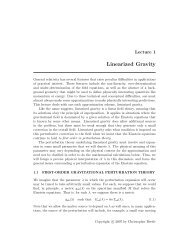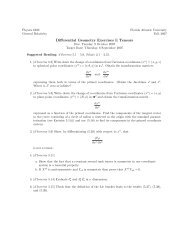Counterion condensation and fluctuation-induced attraction
Counterion condensation and fluctuation-induced attraction
Counterion condensation and fluctuation-induced attraction
- No tags were found...
Create successful ePaper yourself
Turn your PDF publications into a flip-book with our unique Google optimized e-Paper software.
COUNTERION CONDENSATION AND FLUCTUATION- ...PHYSICAL REVIEW E 66, 041501 2002FIG. 5. The pressure profile for monovalent counterions in thecase of moderate coupling g1.strong repulsive force, such as hardcore or hydration force,that we have not taken into account in our model, may becomeimportant <strong>and</strong> may overwhelm this correlated <strong>attraction</strong>at length scale less than 20 Å 1. This may explainwhy <strong>attraction</strong> is difficult to observe experimentally formonovalent counterions. Moreover, the pressure profile forlarge separations is similar to that of the PB theory, exceptwith a renormalized or effective surface charged density. Indeed,it is known experimentally that in order to fit experimentaldata to the PB theory, it is necessary to use an effectivesurface charge, which is always lower than the actualsurface charge density 1. Therefore, this counterion <strong>condensation</strong>picture provides a possible scenario in which thisphenomenon can be accounted for theoretically, without invokingcharge regulation mechanism.However, for c the behavior of the order parameter <strong>and</strong> the total pressure of the system is qualitatively differentsee Fig. 4. We find that there is a range in the couplingconstant, g ()/2gg (), in which the order parameterdisplays a finite jump at a particular separation d 0 (g,), <strong>and</strong>the counterion <strong>condensation</strong> is first order as a function of theseparation d. Here, g () denotes the coupling constant atwhich the first-order counterion occurs at infinite separation,i.e., an isolated charged plate see Sec. II <strong>and</strong> Ref. 14.Thus, in the limit g→g (), we must have d 0 (g,)→,since the system is composed of two isolated charged plates.However, we have d 0 (g,)→0 asg→g ()/2, because thislimit corresponds to a single charged plate with twice of thesurface charge density, i.e., 2en 0 . This striking behaviorof the order parameter has interesting implications for theinteraction for the system. Indeed, for sufficiently short distances,we find that the first-order counterion <strong>condensation</strong>spontaneously can take the system from the repulsive to theattractive regime, resulting in a first-order binding transition.This is illustrated in Fig. 6 for the case of trivalent counterionsat room temperature 0.01 at g1.3, corresponding toa surface density of one charge per 70 nm 2 . For trivalentcounterions, the first-order counterion <strong>condensation</strong> occursin the range of 0.9g1.8 14. The correspondingpressure profile is plotted in Fig. 7, which shows that theFIG. 6. First-order binding transition: for the case of trivalentcounterion (0.01), the number of condensed counterions ()exhibits a discontinuous jump at a particular distance.binding transition occurs at about d10 Å. We note that aninteresting consequence of this first-order binding transitionis the existence of metastable states, which may have importantmanifestations in surface force experiments. It is easy toimagine that the system can be trapped in different metastablestates, <strong>and</strong> therefore, hysteresis may occur as the twosurfaces are pushing in <strong>and</strong> pulling out again. Indeed, there issome experimental support for this behavior for multivalentcounterions in similar systems 31. It is important to emphasizethat this interesting behavior is not included in themean-field PB theory. Note also that this first-order bindingtransition can only take place at short distances. This is becaused 0 (g,) generally increases with increasing g, <strong>and</strong>eventually when g is near g (), the <strong>condensation</strong> occurswithin the repulsive regime <strong>and</strong> the binding transition becomescontinuous. Thus, direct experimental observation ofthe first-order binding transition may prove subtle.Finally, For gg () <strong>and</strong> c , the <strong>condensation</strong> againbecomes continuous. This is because the first-order phasetransition has already occurred at infinite separation, inwhich 1. In this regime, the length scale at which theFIG. 7. The pressure profile for the first-order binding transition.041501-9






